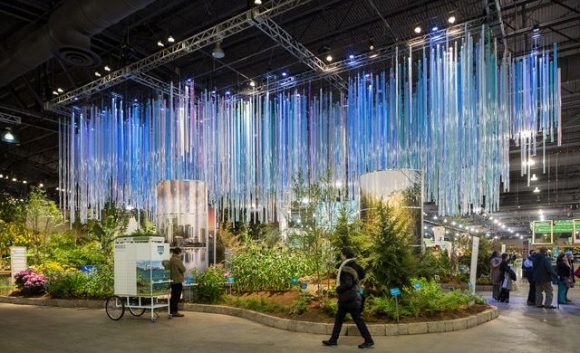IMAGE OF THE WEEK

A photo by Tara Mazurczyk of Inventory: Rain and Water, an exhibit at the 2018 Philadelphia Flower Show she and others helped artist Stacy Levy to design. If the name Stacy Levy sounds familiar, it may be because she is the artist who created the Ridge and Valley watershed map at the Arboretum, featured on the cover of our fall 2013 newsletter.
GOOD NEWS
- The Department of Geography is launching its new website today, March 20, 2018! If you are trying to use the website, you may experience a service disruption during the transition process. The URL will be the same: www.geog.psu.edu, however any links to pages within the site will no longer work after today. Starting March 21, check any links you currently have to our website, and contact geography@psu.edu if you are having trouble linking to the pages or content you seek.
- The Penn State GIS Coalition has officially been accepted as a Youthmappers chapter.
- Congratulations to Stacey Olson on passing her M.S. Proposal Defense.
- Congratulations to Jamie Peeler on passing her Ph.D. Proposal Defense.
- Megan Baumann received a Global Programs Travel Grant to present research at the Conference of Latin Americanist Geographers (CLAG) in May in Costa Rica. Her paper is titled: “Living a callejera methodology: grounding Lugones’ streetwalker theorizing in a feminist decolonial praxis.” She will also be organizing a panel with Kelsey Brain on “Intersectionality and coloniality in human-environment geography: Empirical contributions to feminist theory from Latin America.”
COFFEE HOUR
Coffee Hour: Kendra McSweeney on “Drug policy and environmental change: lessons from Central America”
This presentation has two aims. First, I offer an overview of recent collaborative research that identifies the ways in which global drug policies are driving unexpected changes in land use, land cover, and agrarian futures in drug transit zones. Drawing from research in rural Central America, with emphasis on Honduras, I describe the logics, patterns, and processes driving narco-led transformations, which are profoundly shaped and intensified by specific U.S.-led counterdrug approaches. I discuss the implications of those findings for how we understand illicit economies, commodity chain geographies, and frontier transformations more generally. Second, I reflect on my research team’s collective experience doing and presenting this work, including a) the challenges of researching illicit activities in general; b) presenting our mixed-method research to international and national drug policy audiences; c) the opportunities and risks associated with working with media to mobilize our findings.
- This talk is sponsored by Supporting Women in Geography (SWIG)
- 3:30 to 5:00 p.m.: Refreshments are offered in 319 Walker Building at 3:30 p.m.; the lecture begins in 112 Walker Building at 4:00 p.m.
- No Coffee Hour To Go: This talk is available live and in-person only. There will be no webcast and no recording.
NEWS
Researchers create tool to better geographic projections in atmospheric modeling
Open-source code developed by a Penn State graduate could improve weather forecasting and a range of other research endeavors that rely on pairing atmospheric models with satellite imagery.
Yanni Cao, who earned her master’s degree in geography in 2016, developed the code while a member of Penn State’s Geoinformatics and Earth Observation laboratory (GEOlab) as a way to fix errors created when satellite data is combined with the Weather Research and Forecasting (WRF) model. The work was done in collaboration with her adviser, Guido Cervone, head of GEOLab, associate professor of geoinformatics and associate director of the Institute for CyberScience, and the National Center for Atmospheric Research (NCAR).
Conservation and diversity: Lives, languages and land in the balance
“Linguists reckon we lose a language every two to three weeks. Species extinction rates are about 1,000 times higher than they were before people showed up. None of that is good news,” said Larry Gorenflo, professor of landscape architecture and geography at Penn State.
Gorenflo conducts research to understand how cultural and biological diversity co-occur in the hope of helping to conserve both. Gorenflo also holds the Eleanor R. Stuckeman (ERS) Chair in Design which provides him with support to further his ongoing inquiries. His research has demonstrated that places with a high number of species also feature high numbers of indigenous languages. He added, “Both are disappearing at alarming rates.”
From Portland State University News
Portland State professor helps bring forests of the future to life
Research team members include Penn Staters Erica Smithwick, Alexander Klippel, Nancy Tuana, Rebecca Bird, Klaus Keller and Robert Nicholas
What if you could see what a forest might look like 50 or 100 years from now? Imagine being able to see how a warming climate turned a dense forest into sparser woodlands.
Soon, there will be an app for that. With just a smartphone and a cardboard headset, users will be able to immerse themselves in a forest years into the future.
Portland State University researcher Melissa Lucash is part of a team that is working to visualize how a variety of factors – including climate change, wildfires, insect invasions and harvesting practices – can alter a forest and how that information can then be used by forest managers when making decisions.
